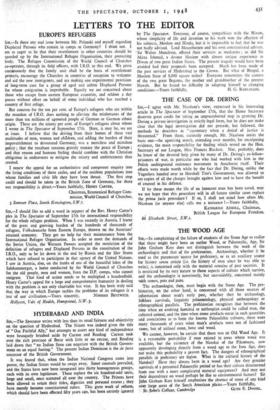THE WOOD AGE
SIR,—In complaining of the failure of students of the Stone Age to realise that there might have been an earlier Wood, or Palaeoxylic, Age, Sir John Graham Kerr does not distinguish between the work of the archaeologist and that of the prehistorian. Archaeology, whether it be used as the paramount source for prehistory, or as an auxiliary source for history sensu stricto (i.e. the history of man since he was able to write), is concerned only with the material remains of past societies. It is restricted by its very nature to those aspects of culture which survive, and the archaeologist is notoriously, but unavoidably, concerned mainly with stones, pots and pans.
The archaeologist, then, must begin with the Stone Age. The pre- historian, on the other hand, is concerned with all those sources of information about man's early past, whether they be archaeology, folklore survivals, linguistic palaeontology, physical anthropology or ethnographical parallels. The prehistorian recognises that between the time when an evolving hominid or anthropian could be called man, the cultured animal, and the time when stone artefacts occur in such quantities and associations as to form the known Palaeolithic cultures, there were many thousands of years when man's artefacts were not of fashioned stone, but of utilised stone, bone and wood.
We cannot, however, be certain that there was an Old Wood Age. It is a reasonable probability if man existed in areas where wood was available, but the existence of the Natokoi of the Pilcomayo, now apparently developing directly from a wood age to the Iron Age, does not make this probability a proven fact. The dangers of ethnographical parallels in prehistory are legion. What is the cultural history of the Natokoi? Have they always been in a wood age? Are they genuine survivals of a presumed Palaeoxylic period or has their culture deteriorated from one with a more complicated material equipment? And may not their dependence on wood perhaps be due to environmental factors? Sir John Graham Kerr himself emphasises the absence of stone of any kind over large areas of the South American plains.—Yours faithfully,


































 Previous page
Previous page